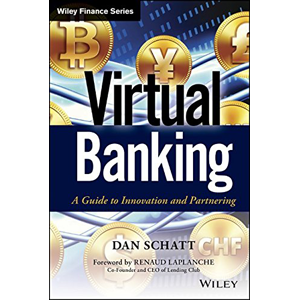by Chetan G. Shah, CFA, CFA Institute
Virtual Banking: A Guide to Innovation and Partnering. 2014. Dan Schatt.
Until the 1950s, local bankers knew their customers intimately and provided the level of attention and services that come with years of interaction. With the rapid expansion and globalization of banks, that customer connection seemed to disappear. It is now making a comeback — through the use of technology, be it social media, mobiles, or analytics that use big data.
Despite banks’ responsibilities as custodians of the public’s deposits and their need to manage risks and comply with numerous regulations, banks have been slower than other industries to adopt new technologies. Some, however, are partnering or collaborating with nimble-footed technology companies and following well-thought-out plans to meet the expectations of today’s consumers.
In the past, the proximity of the bank branch used was the primary reason for opening an account with a bank or switching to another one. Now, according to a recent survey of younger customers, the desire for mobile banking capabilities is a main motive for switching banks. The three main features that attract these customers are mobile remote deposit capture, mobile payments, and actionable offers.
In Virtual Banking: A Guide to Innovation and Partnering, Dan Schatt — former head of financial innovations at PayPal and currently the chief commercial officer of Stockpile — provides an excellent view of the changes taking place in banking and financial services thanks to changes in consumer behavior and advances in Internet and mobile banking. Most of the innovations are occurring outside banking. If banks do not adopt these innovations, they run the risk of becoming irrelevant to their customers. “Banking is necessary, but banks are not,” Bill Gates famously said in 1994. The statement remains valid today.
Schatt gives a number of examples of how banks are successfully implementing social, mobile, and big data technologies in serving their retail customers. Banks in Poland can now deliver special offers to customers directly in their Facebook accounts, personalized with respect to their transactions. The Commonwealth Bank of Australia can facilitate peer-to-peer payments between Facebook “friends” by using mobile phone numbers and addresses and can enable customers to request payments, check balances, and transfer money between accounts. In India, ICICI Bank gives its customers account information through Facebook, an application that is hosted on the bank’s servers.
In France, Crédit Agricole introduced a financial application marketplace called the CA Store, modeled on Apple’s and Google’s method of recruiting outside developers. It exposed a set of APIs (application programming interfaces) to external developers to build applications and solutions compatible with its own system. This approach afforded clients a better customer experience. The developers are paid on the basis of client usage. The three principles that guided Crédit Agricole in this successful venture are:
- Trust the customers for ideas.
- Open only the data of the application developers.
- Make the applications secure.
People in emerging markets are quickly gravitating toward mobile banking because traveling with cash or storing it at home is dangerous. For customers of Safaricom and Vodacom, the largest mobile networks in Kenya and Tanzania, respectively, using a mobile phone eliminates a great deal of risk because if the phone is stolen, the thieves will have to know both the code to unlock the phone and the code to enter the owner’s M-Pesa account. M-Pesa is a mobile-phone-based money-transfer and microfinancing service launched by Vodafone in 2007. It allows a user with a national identity card or passport to deposit, withdraw, and transfer money easily with a mobile device. In Kenya, virtually every adult has an account with M-Pesa and manages money and payments by mobile phone.
The fascinating thing about M-Pesa — aside from the fact that it is run by a mobile carrier, not a bank — is that it has made banking services available for the first time to an entire population. By breaking up their transfers into smaller pieces, urban migrants end up remitting more money back home. In addition, rural recipients save money when retrieving cash. They no longer need to pay for transport costs to urban centers, where most of the money-transfer services are located. Instead, they make withdrawals directly. Although a bank sits behind the account, everything is controlled by the mobile network. M-Pesa has demonstrated that its ability to do business with the poor in a responsible way can be both profitable and sustainable. In Kenya, the banks are in catch-up mode.
In the spring of 2013, bitcoin received a lot of bad publicity when its value soared to $250 and then plunged to less than $100 in a matter of days. Its use in such illicit activities as drug sales further damaged its reputation. Schatt argues, however, that the technological foundation of math-based currencies (MBCs) could prove transformational for financial institutions. Bitcoin’s core functions are currency mining, transaction logging, and ledger replication. The robustness of the protocol has kept this core of the ecosystem free of security issues and breaches. Merchant services, wallets and vaults, currency exchanges, and secondary markets constitute the enablers and complete the bitcoin ecosystem.
One of the simplest uses of MBCs involves a payment rail. This transaction is a “push” payment between two endpoints, so it avoids settlement risk. There is no authorization message or hourlong settlement lag. Because entering the transaction into the block chain (the public transaction ledger) to produce validated evidence of its application would take 8–10 minutes, it is best suited for such business-to-business segments as interbank trading and settlement, online micropayments, and international money remittances — all at a fraction of the cost of conventional methods.
Among the distinctive features of Virtual Banking are the inclusion of interviews of experts across a range of technology and financial services and a few pieces written by some of these experts. The interviewees include Dana Stadler, a partner at Matrix Capital and former COO of PayPal; Scott Thompson, CEO of ShopRunner and former president of PayPal; Meyer “Micky” Malka, a serial entrepreneur and currently a partner at Ribbit Capital; Renaud Laplanche, CEO of Lending Club; and Brett King, CEO of Moven. Authors of the contributed articles include George Peabody of Glenbrook (math-based currencies); Neil Hiltz, head of global vertical marketing for financial services at Facebook (how banks can take advantage of social trends); Matt Harris, a partner at Bain Capital Ventures (prepaid cards and trends in financial technology); and Peter Aceto and Charaka Kithulegoda, CEO and CIO, respectively, of ING Direct Canada.
Virtual Banking is at the intersection of banking, financial services, and technology. Technological frontiers include geolocation capabilities to enable pop-ups and alerts on the mobile phones of consumers whenever they pass favorite malls or restaurants. The fingerprint access introduced on smartphones, card details stored in digital wallets, the acceptance of near-field communications as a standard, and contactless point-of-sale terminals at stores — all will lead to “one-click” payments. The pace of innovation is so rapid that Schatt will need to update this book in the near future.
More book reviews are available on the CFA Institute website or in the Financial Analysts Journal.
If you liked this post, don’t forget to subscribe to the Enterprising Investor.
All posts are the opinion of the author. As such, they should not be construed as investment advice, nor do the opinions expressed necessarily reflect the views of CFA Institute or the author’s employer.
Chetan G. Shah, CFA
This article was originally published at the CFA Institute's Enterprising Investor Bog.















